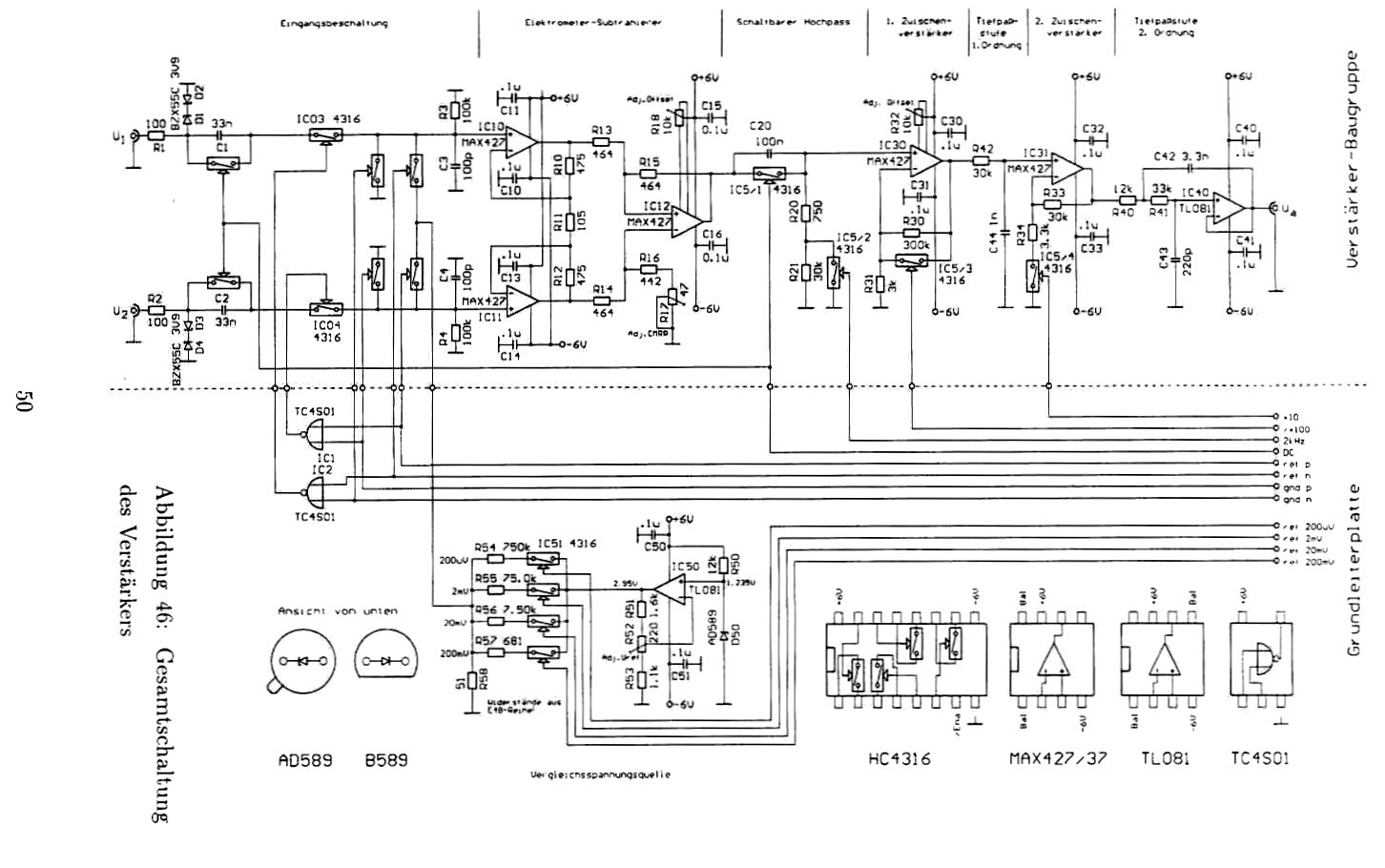back
First Acoustic Camera
Funktionen PSI-Tools
Mikrophon-Arrays
Interferenzschaltungen
Software PSI-Tools
Hardware for PSI-Tools
16-Channel Preamplifier
Find here some images of the hardware (until 1997), used to make records for first electric and acoustic interference integrals (acoustic images, nerve images and -films).
The Toshiba-laptop we used was one of the very first in the world. And this wonderfull compact sized Toshiba from 1996 was very expensive, it costs some thousand Deutsche Mark (DM). It had a docking station with a full-Size AT-bus slot. Perfect for our full-size ADC-card WIN30DS with 16 channels! The ADC-card contained no Nyquist-filters. So it was necessary, to develop a preamplifier box containing the 16 filters.The fat flex-cable in the background connects the 16-channel preamplifier box (right). It carried the 16 analog channels and control signals to set the filter-circuits.
The preamplifier contained for each channel the ADC-aliasing filters and adjustable highpass and lowpass filters.
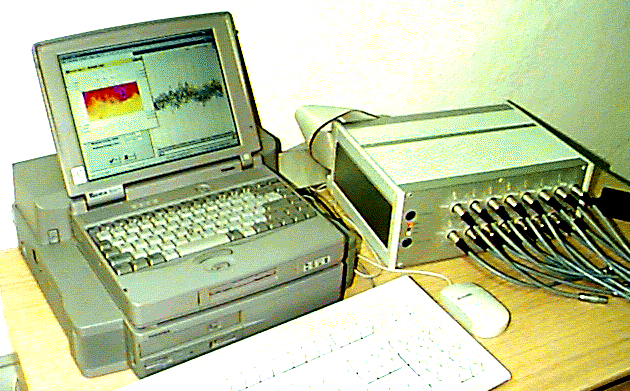

First small sized PCs for industrial measurements (left Toshiba-Laptop 1995, right UMC-PC 1996). Both included a full-size PC-AT-slot for the 16 channel WIN30DS ADC-card
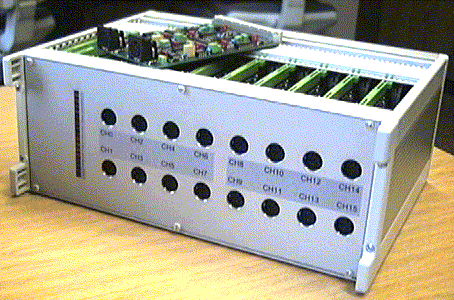

16-channel, 32 Bit digital controlled preamplifier for EEG- and acoustic measurements with the WIN30DS ADC-card (Carsten Busch, Gerd Heinz)
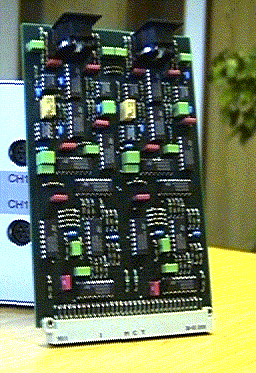
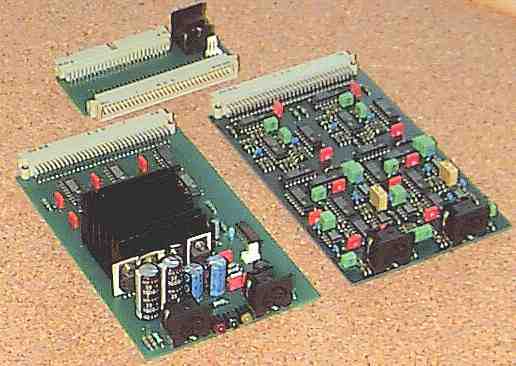
Boards of the digital controlled preamplifier. Left image: Preamplifier card for two channels. Right image: Left: Power control with Klicker-Interface to start the measurement
Technical details:
- The preamp was placed within the microphone array box
- Low-noise-optimised for small signals
- Input range 10µV to 20Vpp in 16 stages
- Complete 32 bit, soft-controlled, soft-initialized
- Save set of custumer initialisations on startup via *.INI-file
- 32 switches per channel
- Frequency range -1dB 0.05Hz to 50kHz
- Double low-pass filter before AD-Conversion switchable in six stages each
- Double high-pass filter before AD-Conversion switchable in eight stages each
- External/internal trigger to start conversion
- Sync-output for conversion start possible
- Sample rate max. 50 kHz (100 kHz) per channel, dependend of ISA-Bus
- Volume 35x14x26 cm
- Weight approx. 5 kg
- Internal CE-verified power supply 230V~
Remark 2023:
Why was is necessary, to develop a big preamplifier box with 32 filter switches per channel? There were three aspects.If one gets an analog signal with a bandwith higher the Nyquist-frequency fs/2, the sampling produces additional noise by frequency aliasing. So each ADC has to band-limit the incomming signal using a low pass filter below fs/2.
- The ADC-converter of the WIN30DS-card had no aliasing-filter
- We need a very high amplification to reach EEG-sensitivity
- To filter (lowpass, bandpass, highpass) the data in software was much slower then with hardware
Today we use ADCs working with ΔΣ-technology. They include the band limiting filter using a simple oversampling technology. Our WIN30-DS-card contained an ADC without any filter. So we had to implement a filter for each channel. Too I would be sure, that we will not get any aliasing effects only solveable with additional analog filter hardware.
ADCs working with ΔΣ-technology came into the market, when the amplifier development was finished.For the next generation of the data recorder (1997) we used the brandnew 16-bit ΔΣ-ADC AD7722 from Analog Devices. With 220 kSps it was able to analyse ultrasonic sound until 100 kHz. It had a 16-Bit wide parallel port to couple four ADCs with a fast page mode dRAM from Samsung KM416C4100CS-5 with 4M x 16bit as data buffer. Storable were 1 Mio. samples per channel (4M / 4). With highest sample rate of 197 kSps it could store 5 seconds, with moderate sample rate of 48 kSps we got 20 seconds and with 24 kSps we got 40 seconds recording time.
16-Channel Analog-Digital-Converter Card

UEIDAQ WIN30DS card within an IBM-PC i486 (1995)
The 12 bit analog-digital converter UEIDAC WIN30-DS for 16 channels was a full sized ISA-board within the personal computer (IBM-PC-AT i486). 4 ADC-cards (64 channels) were possible. The ADC contained no Nyquist-filter. Sample rate max. 100 kHz per channel, dependend of the PC-ISA-Bus used.
8-Channel Preamplifiers (1995)
I wrote the book "Neuronale Interferenzen" (Link) in the hope, to get spike-like nerve signals from everywhere in the nerve-systeme, to reconstruct them like in the thumb-experiment. So an ADC with a (for 1994) very high sampling rate (50/100 kS/sec) and 16 channels was ordered, the UEIDAQ WIN30DS, and "high frequency" EEG-preamplifiers were developed (EEG-amps had in tis time samplerates of max. 2 kS/sec).
Unfortunately we did not find any rests of spike-like signals from Electro-Encephalograms (EEG) or Electro-Cortikograms (ECoG) we got.
So what to do? We had to expand our perspective. I ordered 8 electret-microphones at Conrad and built an adapter for the amplifier. And within two weeks we had the first acoustic image (Aug. 23, 1994) - with very poor quality and a bug in the color table, but it was the worldwide first acoustic image (of passive type) (Link). This changed everything:
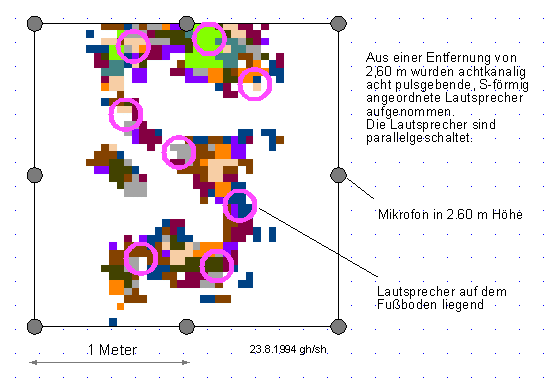
First passive acoustic image. Software: Sabine Höfs (geb. Schwanitz). Hardware: Carsten Busch, Gerd Heinz. Records and calculation: Gerd Heinz
It brought lots of questions: "Did you ever heared something about an acoustic image? No?" and "How many acoustic institutes worldwide would research on such things?"
We found, that 1994 were approximately 1800 acoustic institutes in the world, most of them working at so called "beamforming" questions. "Why didn`t they do their job? - Why we? - What have we done?" we asked us. Nobody of us had studied acoustics. We were newcomers in the field. Very slowly we realized, that we opened a new scientific field. So we proceed.
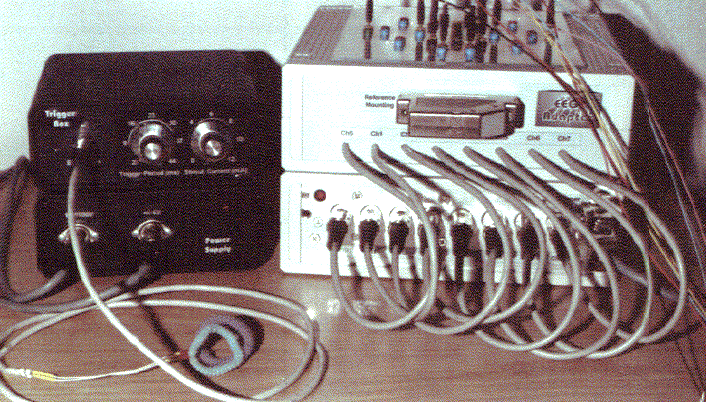
Developed as 8-channel EEG-preamplifier for EEG-experiments (V.2, 1995) with EEG-adapter on top. Left: "Trigger-Box" for electric stimuli and the "Power Supply"

8-channel, frequency-selective EEG-preamp V.1 (1994). It was the preamplifier for the first acoustic image.
Pilot Version of the Amplifier
Michael Fritsch, FHTW Berlin-Karlshorst, FB3, developed in his diploma-thesis 1994 the prototype for the "high-freqency" (50 kHz), soft-controlled preamplifier for the WIN30-DS-card.
Sources
- Heinz, G.: Verfahren und Prototyp zur Rekonstruktion eines dreidimensionalen, neuronalen Interferenzraumes. Kurztitel: Neuronale 3D-Rekonstruktion (NEURO3D)". Projektförderung durch BMWi, Nr. 415/1994, 1.1.1994 - 30.6.1995, GFaI Berlin, Sachbericht vom 20.12.1995, 41 S.
- Heinz, G.: Verfahren und Prototyp zur Erzeugung von Präzisionsbildern akustischer Laufzeitfelder durch Nutzung paralleler und serieller Interferenz (PSI). Projektförderung durch BMWi, Nr. 744/95, 1.6.1995 - 31.5.1996, GFaI Berlin, Sachbericht vom 1.12.1996, 16 S.
back E-mail: info@gheinz.de
File created Jan. 12, 1996; revised: Jan. 15, 1996,
Adds 11/1997, 2/2023, 07/2025

